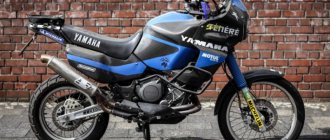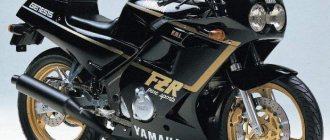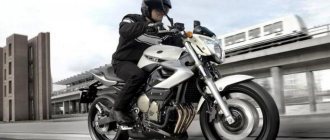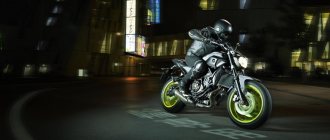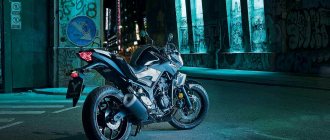Bike features
Here are the main features of the bike:
- long-travel suspensions with adjustable capabilities;
- spacious fuel tank;
- fuel injection system.
Perhaps the most important feature of this touring enduro from Yamaha is that it has a 23 liter gas tank to travel about 600 km. This is a very impressive figure, because many motorcycles can only travel 300 km. For the Yamaha XT660Z Tenere this is very important, because this bike is designed for long trips.
Successful revival:
Adjusting the valves is a simple process, but the problem is that you have to disassemble half of the motorcycle - remove the gas tank, plastic and radiator. But there is also a positive point, which is that the valves are adjusted with screws, and not with shims. On the one hand, this is simpler, since you don’t need to order these washers, but on the other hand, according to the service regulations, you need to carry out the adjustment once every 6000 km and you will need a special key for adjustment. However, you can easily make this key yourself or replace it with pliers, although in this case the adjusting screws can be damaged.
So, we remove all the parts that make access to the valve covers difficult. We read the service manual and find out that for intake valves the gap on a cold engine should be 0.10...0.15 mm, and for exhaust valves - 0.15...0.20 mm. We unscrew a couple of caps on the left side that cover the crankshaft position control holes. Turn the motor counterclockwise until we see the “I” mark, which comes after the “H” mark.
We need the “top dead center” of the compression stroke, when the valves are completely closed and there is no pressure on them from the camshaft. Since the full working cycle of a four-stroke engine occurs within 720 degrees or two engine revolutions (this is in simple, worker-peasant terms, so that even my critics from Moto.ru understand this), it is possible that the mark will be set correctly, but it will be necessary Make another full rotation of the engine to get the engine in the correct position to adjust the valves. The compression stroke can be recognized by the characteristic hiss of compressed air or by observing the valves by opening their covers. Again, for the most curious readers, especially the administration of moto.ru, I will give an excellent moving picture, which should, in theory, explain why we are looking for the top dead center of the compression stroke. Although you can take my word for the service instructions, this is not an option for Internet “fighters against profanity”? 
In the case of the Yamaha XTZ 660, five valves will need to be adjusted - two on the exhaust and three on the intake. Turning the valve adjustment is extremely inconvenient, as is adjusting the carburetor - there is not enough space, either the ignition coil or the throttle cable is constantly in the way. So I recommend dismantling them too - it will help a lot when adjusting the intake valves.
Why do we adjust valve clearances? The fact is that the engine heats up, the valve material expands and the valves slightly change their size. It is to compensate for this that “thermal gaps” are needed. With the correct clearances, a warm engine opens and closes the valves as intended by the engine designers. Therefore, thermal clearances must be within the limits specified in the service manual. The following photo shows these gaps, which are to be adjusted - the thermal gap on the middle valve is increased for demonstration purposes.
The adjustment is done like this: take a feeler gauge with a maximum clearance rating (0.20 for exhaust, 0.15 for intake), insert it into the gap between the valve and the pusher. Then we tighten the adjusting screw until it lightly presses the tsup so that it can be pulled out with a little effort. Then hold the adjusting screw in this position using a special tool so that it does not turn, and tighten the locking nut. In general, it is supposed to be tightened with a torque of 14 N/m, but in this case I tightened the nut with an ordinary wrench with an approximate force - I do not have an open-end torque wrench.
After tightening the locking nuts, take feeler gauges of a smaller value (0.10 for intake and 0.15 for exhaust) and check the gaps. If they are placed in the thermal gaps, but the next rated probe is no longer there, then everything is adjusted perfectly, exactly as the instructions say - the real gap between the specified minimum and maximum. We carefully turn the engine with the key a few turns to make sure that nothing is knocking, after which we can begin to screw all the dismantled parts of the motorcycle into place. For those who do not want to break the adjusting screws with pliers, I provide the dimensions of the special tool for adjusting the valves. The adjusting screw cap has a square cross-section, with a side of 3 mm; the measurement of the dimensions of the wrench is shown in the photograph.
PS Today is PR day for Moto.ru, a return courtesy, so to speak. So, especially for the administration of this wonderful humorous site dedicated to motorcycles, I inform you that when adjusting the valves, the engine will turn easier if you first switch to neutral and unscrew the spark plug. And this is not mentioned in the main text because I consider my readers to be smart people, so there will be no instructions for morons either on the topic of repairs, or on the topic of steering a motorcycle, or indeed on any topic. This is the peculiarity of this site; when something is discussed here, an attempt is made to explain why exactly this should be done. If you find a mistake, tell me and justify it, I will only be glad if it helps me find the truth. Is it necessary to explain that the opinion of some authoritative person in some area may be food for thought, but cannot be evidence of the truth? As they say, if you want to denigrate the material, indicate what exactly the complaints are about, and not in the style of “look at his arguments...”, repeating this abstract nonsense for two weeks. You don’t have enough brains for this - sit and be silent.
So, especially for the administration of this wonderful humorous site dedicated to motorcycles, I inform you that when adjusting the valves, the engine will turn easier if you first switch to neutral and unscrew the spark plug. And this is not mentioned in the main text because I consider my readers to be smart people, so there will be no instructions for morons either on the topic of repairs, or on the topic of steering a motorcycle, or indeed on any topic. This is the peculiarity of this site; when something is discussed here, an attempt is made to explain why exactly this should be done. If you find a mistake, tell me and justify it, I will only be glad if it helps me find the truth. Is it necessary to explain that the opinion of some authoritative person in some area may be food for thought, but cannot be evidence of the truth? As they say, if you want to denigrate the material, indicate what exactly the complaints are about, and not in the style of “look at his arguments...”, repeating this abstract nonsense for two weeks. You don’t have enough brains for this - sit and be silent.
Dimensions and weight
The weight without fuel of this motorcycle is 183 kg. The machine reaches 2248 mm in length, 864 mm in width, and 1477 mm in height. At the same time, its wheelbase will be 1500 mm, and the seat height will be 896 mm. The dimensions of this bike should not be considered excessively large, because it is, after all, a touring model.
Chassis and brakes
The exterior of the XT660Z Tenere is quite successful. Of course, some may say that the bike could be made more elegant, but others will quite rightly argue that a touring enduro does not have to be beautiful at all. The frame of the model is tubular, made of steel. Spoke wheels look quite normal.
A progressive monoshock absorber is used as the rear suspension, and a telescopic fork with dimensions of 43 mm is used at the front. For braking, the XT660Z Tenere gets a 245mm disc at the rear along with a twin-piston caliper, and a pair of discs at the front, measuring 298mm each, assisted by twin-piston calipers.
Review of the Yamaha XTZ 660 Tenere motorcycle
My very first thought when I saw Tenere was “God, he’s so healthy.” I immediately warn short and short-legged riders against this motorcycle. Not your destiny. A wide saddle coupled with a very high seat guarantees you dancing at traffic lights and other joys of life. In short, Tenere is a motorcycle for those who are at least 175 cm tall or have disproportionately long legs. Secondly, it's stupidly heavy. The procedure for getting onto the center stand was torture before I invented the necessary configuration using my own hands and feet; head-on, this procedure is unrealistic, just like lifting a fallen motorcycle - rock on, dear potential owners.
At the same time, it is enough to move away, and the heaviness disappears. Tenere is a good winning option for biker competitions for the slowest route. I saw how they beat a trike in such a competition (no joke). The weight distribution of the hefty motorcycle is simply amazing; on the move it’s like a feather. The center of gravity is significantly lower than, for example, that of Africa Twin, which makes it easier to move around the city. But you should sew the plugs between the rows extremely carefully, despite the absolute ease of control at low speeds, you must not forget about the “adult” dimensions, otherwise problems with neighboring cars are guaranteed.
The engine is incomparable. It pulls throughout the entire rev range. And it’s not childish. Low-speed, with a red zone of 7000 rpm, and also torque-oriented, it allows you to unscrew the handle almost from idle. In the worst case – a second delay, a dissatisfied “bang-bang” - and you are torn from the steering wheel by acceleration. On the highway it is best to drive in fifth, keeping the tachometer at 3000-3500; even this is enough for normal overtaking. If not, go down to fourth and roar forward. At high speeds (150 and above) the power is no longer enough, but for such a motorcycle such speeds are clearly overkill. Firstly, it blows away, and secondly, long-travel soft suspensions perform very poorly at such speeds. So “220” on the speedometer is outright flattery, inherited from the “Super Tenere 750”, which is identical in this control unit. I consider the maximum cruising speed for a single trip on Tenere to be 120-130 km/h, at which you still don’t feel strong wind and the engine doesn’t bother you with roars and vibrations.
But! An equally fantastic suspension allows you to move at the same cruising speed on absolutely broken asphalt. Or on any other hard road. As long as it's not sand. On it, almost 200 kg of motorcycle weight, plus the driver with luggage (God forbid, also a passenger), completely deprive you of control. In short, yes to the dirt road, no to the beach. What do you forget when you fly over classic St. Petersburg dead intersections with tram lines, or go around a traffic jam on the same rails or curbs. Sit comfortably. At first it’s just convenient, after a few hours you understand - Convenient with a capital “C”. In general, the Tenere was initially sharpened for long-range driving, we add a 20-liter tank to the comfort (and I couldn’t achieve a consumption of more than 5 l/100 km on the highway (in the city 7-8 is a real figure)) and we get a power reserve of 400 km, which is quite possible to drive simply in one sitting.
The light is bright. At first I thought about installing xenon lights, then on the evening avenue (even at dusk) I turned on the high beam to scare pedestrians, and was amazed that the road signs “returned” a few hundred meters away. Now I use the distant one with caution, wondering how oncoming drivers see it. Well, it’s true, sometimes I use it during the day in traffic jams. It’s like someone else has quacks there, but I have high beams.
Wind protection is quite decent. Of course, it’s a long way to Golda, but at speed the rain blows to the sides, it doesn’t get very wet at all, and if you also have the flaps on the steering wheel, your hands are almost dry. Of course, at high speeds you have to lie down on the tank, which the motorcycle is clearly not designed for, but the miniature windshield honestly fulfills its purpose.
On a test ride it seemed like it was just a locomotive! Then, however, everything became a little more normal. However, the XTZ 660's traction remains without complaint, and the device literally explodes in any gear. At the top, when the gas is sharply turned off, the engine pauses for a few fractions of seconds, after which it can no longer be stopped until the mark in the red zone. There are no restrictions at a “traffic light” start. It's a long way from a sportbike, but the cars still hold up. The CB-750 has much higher dynamics; you don’t even notice how you reach 120 km/h and beyond - but you need to be able to change gears, as if playing with the clutch. And, of course, the revolutions do not need to be lowered below 5000 - 6000. I don’t even remember about the Planet - there is only a starting jerk there. They won't last long on a Junker in drag racing mode.
Now about traction and power. Here the tenera 660 has no equal among the mots I have tested. You can feel it already from idle. You sharply unscrew the throttle and you get cosmic acceleration. But here it is important not to overdo it - at low speeds at idle there is a risk of stalling. At the bottom you will see traction only in first and second gears. If we talk about the CB-750, then we can say that the traction is smooth at any speed and speed. Power to the brim. The planet has no equal in low-end traction, you can move almost at idle - not a motorbike, but a tractor! But it is more for country and off-piste trips. Junker is out of the game here - not a competitor in the worst sense of the word.
Regarding speed, I would give the first place to the CB-750. Behind it is the Yamaha we are considering, behind it are Juncker and Planet. Accordingly, their maximum speeds are 200, 150, 115 and 110. The Japanese is the leader in my rating of wind protection, which is accompanied by a neat fairing and a wide gas tank. One thing can be said about the wind protection of the rest of the motorcycles - first they installed the glass, and then they started thinking)))
A few words about sound. The single-cylinder engine reveals all the magic of sound - from aspiration at idle to a frantic roar during acceleration. Planet’s is also good, but for me, it’s not as juicy and too sharp. The most successful association for the sv-750 is an electric drill, from buzzing to howling, it does not impress either you or those around you. Junker produces a quieter sound, and also buzzes at the top.
The suspension of the xt660z tenere seemed too stiff to me at first, but that was a false signal. All irregularities are smoothed out perfectly. I had the experience of several “fly-ups” over the road, but I managed to win back with my body and leave my legs on the steps. I tested the motorcycle over many bumps, but it passed them with dignity even at a speed of 80-90 km/h. In comparison, the suspension on the sv-750 is mediocre - not short-travel, but 12 cm at the front end is not enough. You can improve handling by filling with thick fork oil - but then you shouldn’t test any route other than asphalt. If you make the suspension softer, it will start to ripple on uneven surfaces. In principle, the toughest on my list is IZH-Planet. What makes it so is its design – the weak frame, in particular. Driving like this is a step towards suicide. Juncker, on the contrary, is gentleness itself. Riding pleasure comes from the rear shock absorbers and the reach of the front fork, but any bump on the way is a bouquet of the most unpleasant sensations.
Controlling the XTZ 660 is a rather specific process. The agile front wheel follows all the slightest movements of the steering wheel without any problems. Stability when driving on the highway is not lost. The tenner makes it easy to avoid bumps along the most optimal trajectory. However, there is no such monolithic stability as the 750 demonstrates. You realize this especially clearly at high speeds. At the same time, the planet resembles a bicycle, and Juncker is not afraid of gusts of wind from oncoming traffic, but he does not take turns well.
I have no complaints about the brakes. Despite the fact that the front one is single-disk, there are no problems with operating efficiency - pressing with one or two fingers is enough. Well, yes, the rear one is a little sluggish, let's be honest, but you should press the pedal deeply in view of the long stroke. But this is a matter of getting used to or a matter of air in the system, I have not checked yet. But this has its own advantage - it allows you to avoid wheel locking. Other owner reviews about the Yamaha Tenere 660 agree with me, everything corresponds to my feelings. The sv-750 has the most powerful brakes, no doubt about it. The front drum of the Planet is a complete zero, only replacing it with an air fork and a hydraulic disc brake helps. But the rear is so sharp that when you overdrive you skid. Despite its greater weight, the Junker has satisfactory brakes, especially when the front and rear are engaged simultaneously.
Personally, I have not identified any characteristic defects, nor have I noticed them in forums or literature, so I will describe what did not suit me personally:
1. Lack of oil pressure or level sensor
2. Lack of fuel level indicator on a touring motorcycle
3. No kick several times
4. Weight, but it became a minus only when I realized that I was more and more drawn to extreme sports.
5. I wasn’t happy with the light, so I installed xenon.
6. Oil consumption, which still exists.
7. Sometimes I don’t notice the blinking turn signal controls.
Of course, I knew about all these “disadvantages” before the purchase, but when choosing, I wanted this one, although this is the most hemorrhagic option - teners are rare on sale, and therefore difficult to find. But the combination of qualities that so seduced me did not allow me to later doubt the correctness of my choice.
The engine is single-cylinder, liquid, with a two-chamber vacuum carburetor and 5 valves. Very high-torque - on the fifth it pulls from 60 to 160. On the first, up the stairs from a standstill, two people or a + snow scooter + sled with children on the tail in 15-20 cm of snow. 5 speed gearbox. Although it switches noisily, it is easy and neutral is caught very clearly. There is one more feature of the gearbox - when you stand it’s easy to switch 1-N-2-N-1, but in the 3-4-5 area it’s normal only on the move or by playing along with the clutch. Consumption at 70-90 km/h (laden) -4l/100km, if over 120, then around 6.5-7l. Tank 20 l. Like all large single-barreled guns, there is oil consumption. On the trip to Rybachy and back (4600 km average cruising speed 80 km/h) I added about 1600-1800 g, and a week later at one of the stages on the way to the Black Sea - 1350 km. (average cruising 110 km/h) - didn’t add a drop!!! I still don’t understand what the trick is.
I am indifferent to the quality of gasoline. MY favorite (most comfortable) speed on the highway is 110. In the city, I also keep up with 250 because of the size.
By the way, it allows you to drive very slowly. On standard stars, it doesn’t get off the gas. The characteristics of the engine do not provoke aggressive driving. There is vibration, but it doesn't bother me. In winter I rode down to -15, tech. I didn't find any problems either.
The pendants, even with the heaviest load (two people + all the equipment), never broke through. As Bobas noted earlier, the tenera can only be overloaded with bricks.
The frame is very strong and it seems that this is the rare case when it does not need reinforcement (Dakar roots).
The tidy is readable and beautiful. There are no complaints about ergonomics. Visibility in the mirrors is excellent. With a height of 175 and 95 kg, Tenera will allow me much more than me at my 176/65, and she allowed me much more than the Japanese engineers expected.
It was comfortable for the two of me on it, and my other numbers didn’t complain either. Having a passenger changes the dynamics, etc. not essential for traveling (on hard surfaces, of course).
